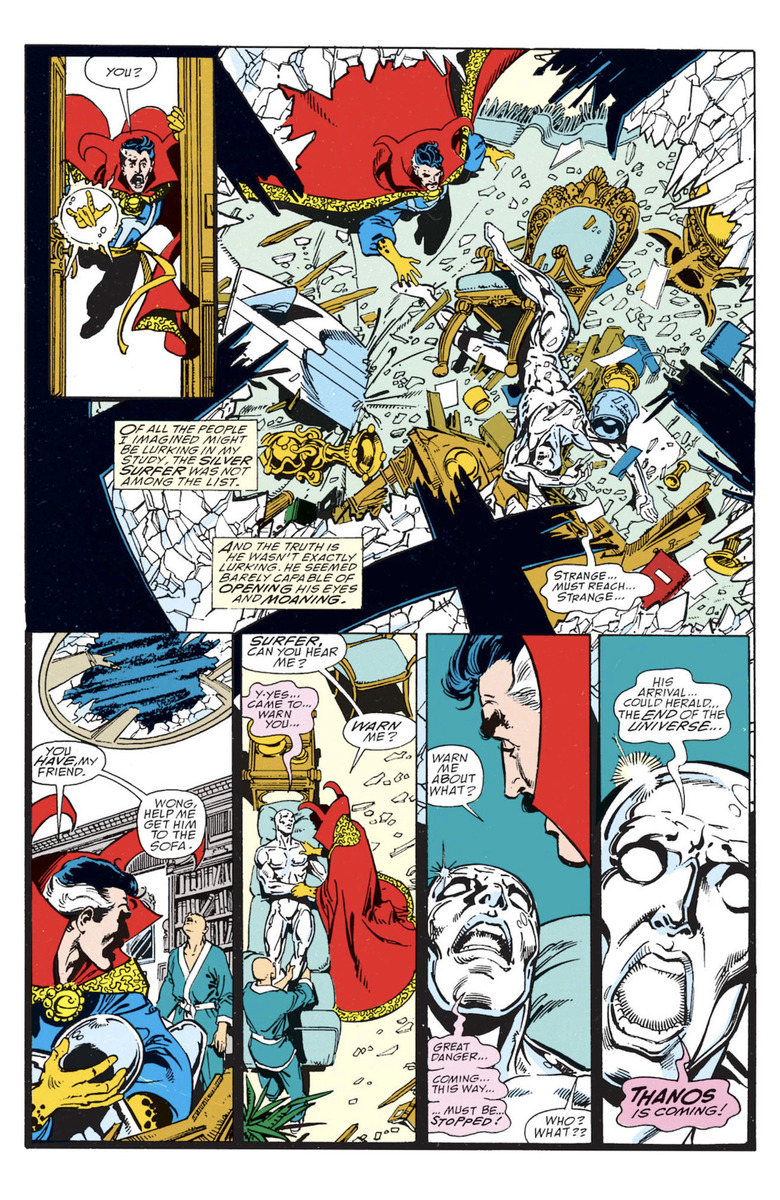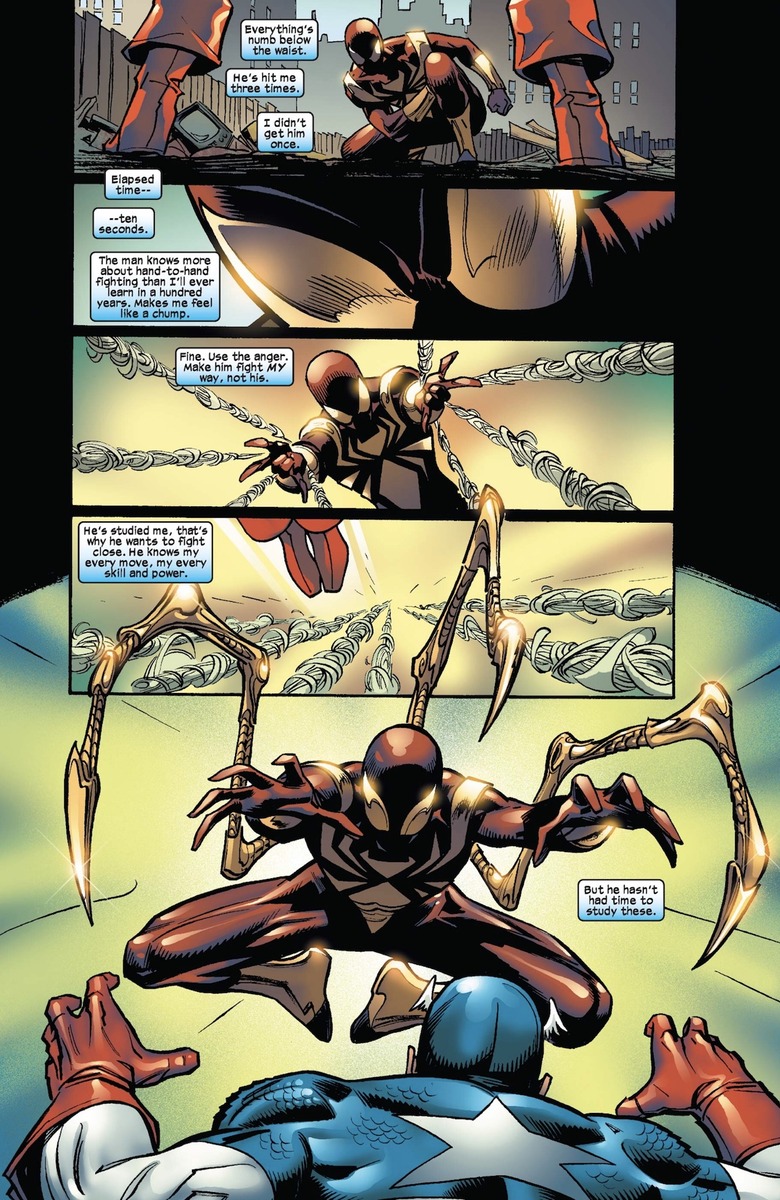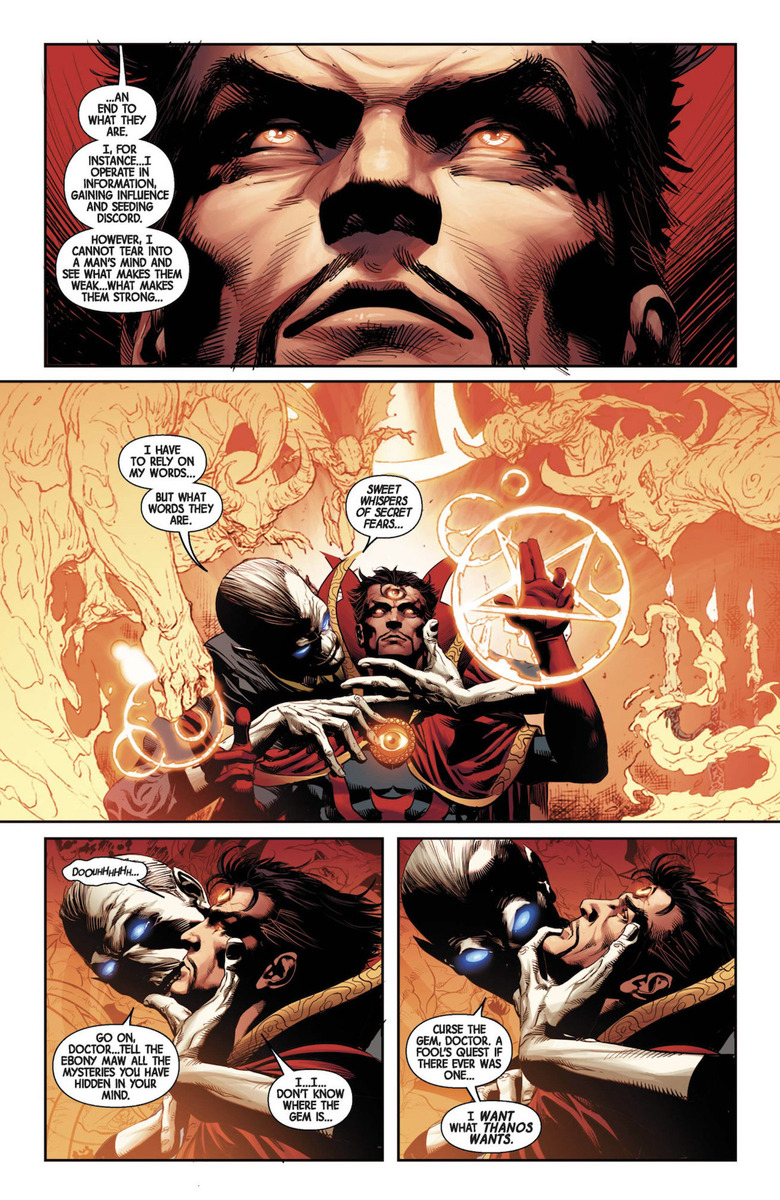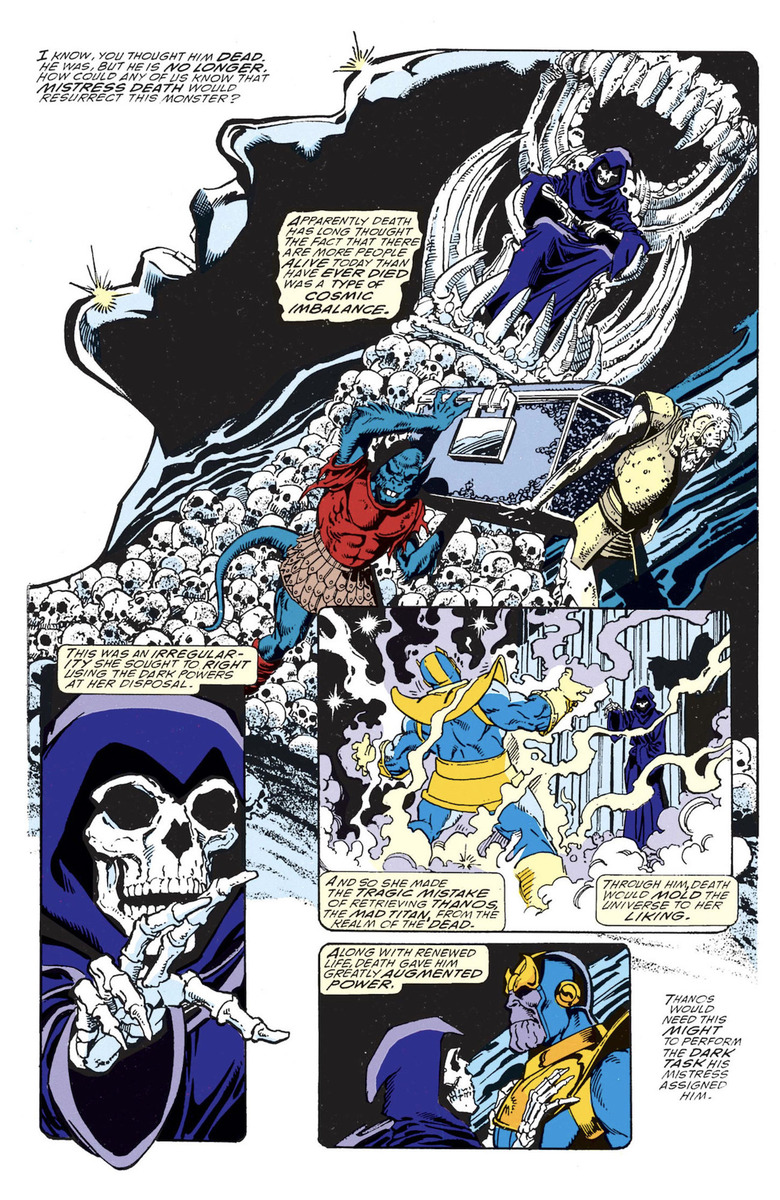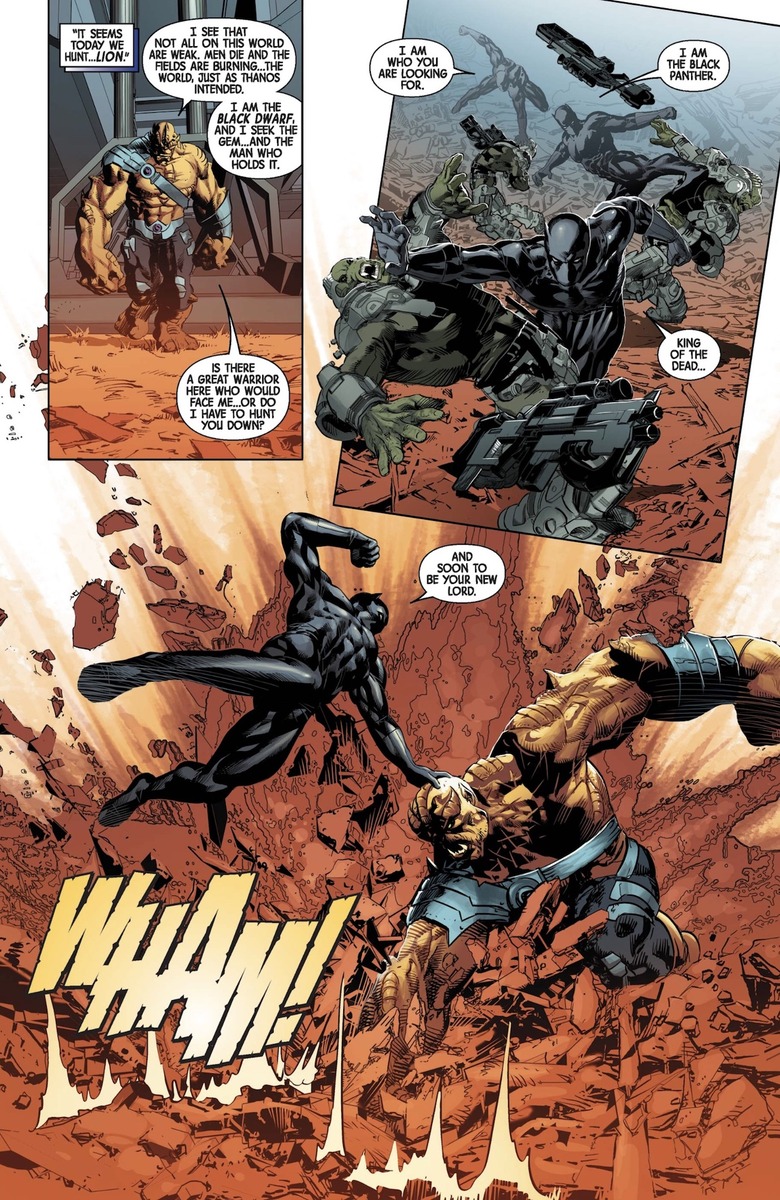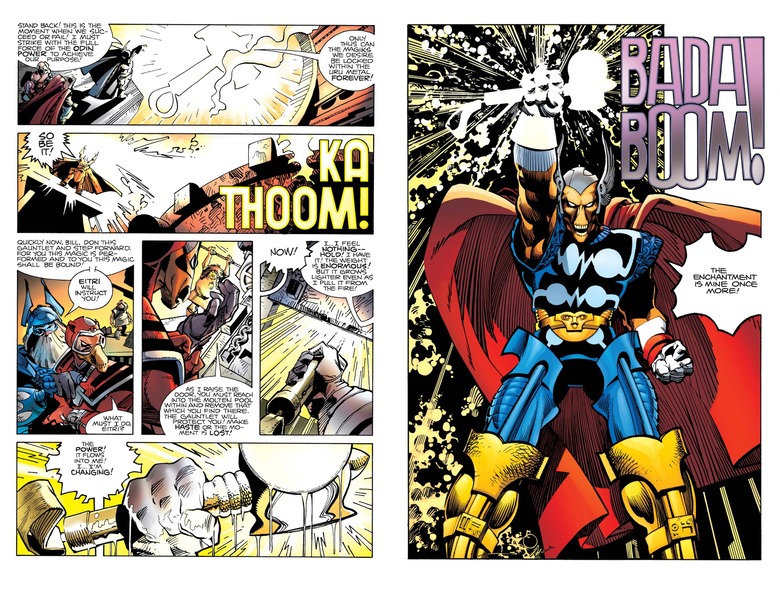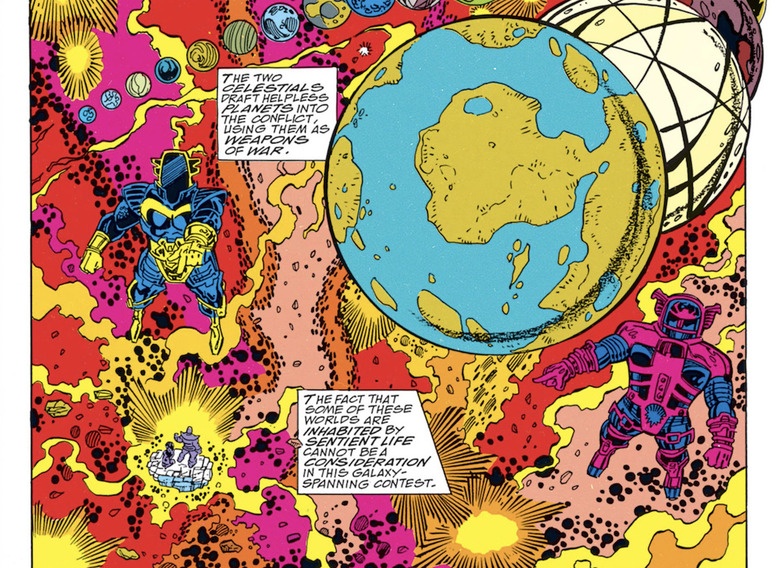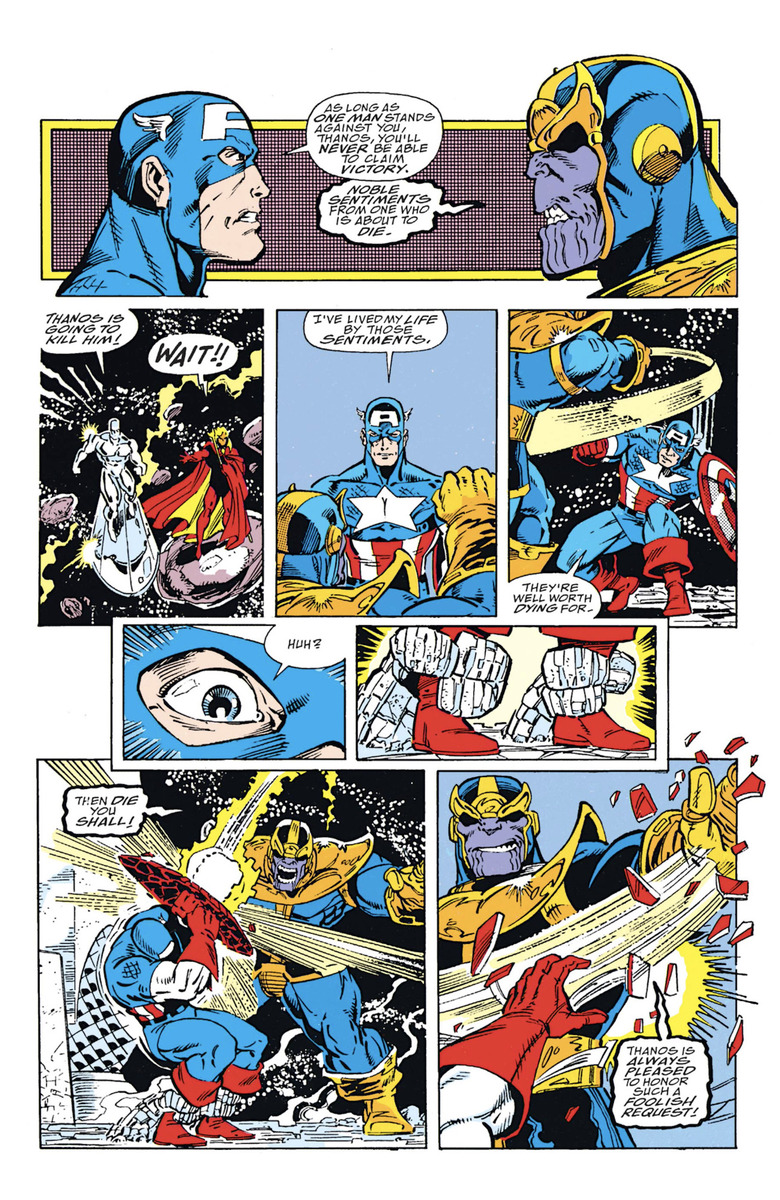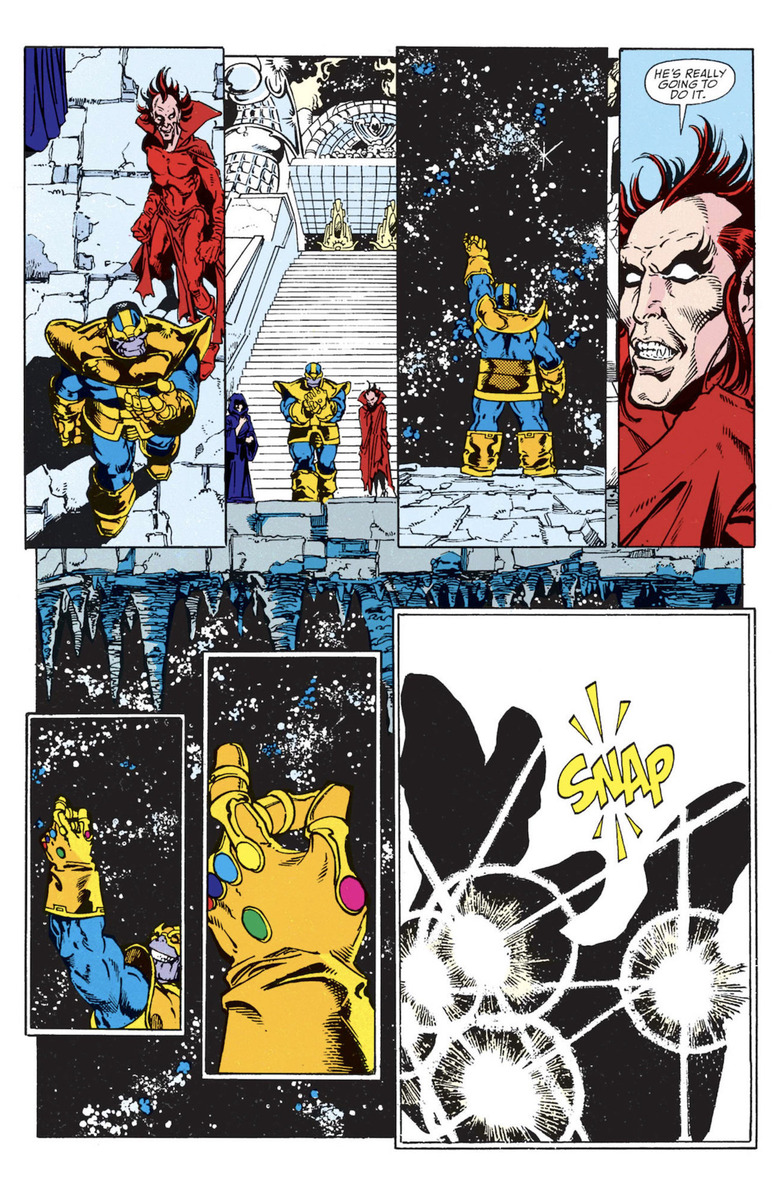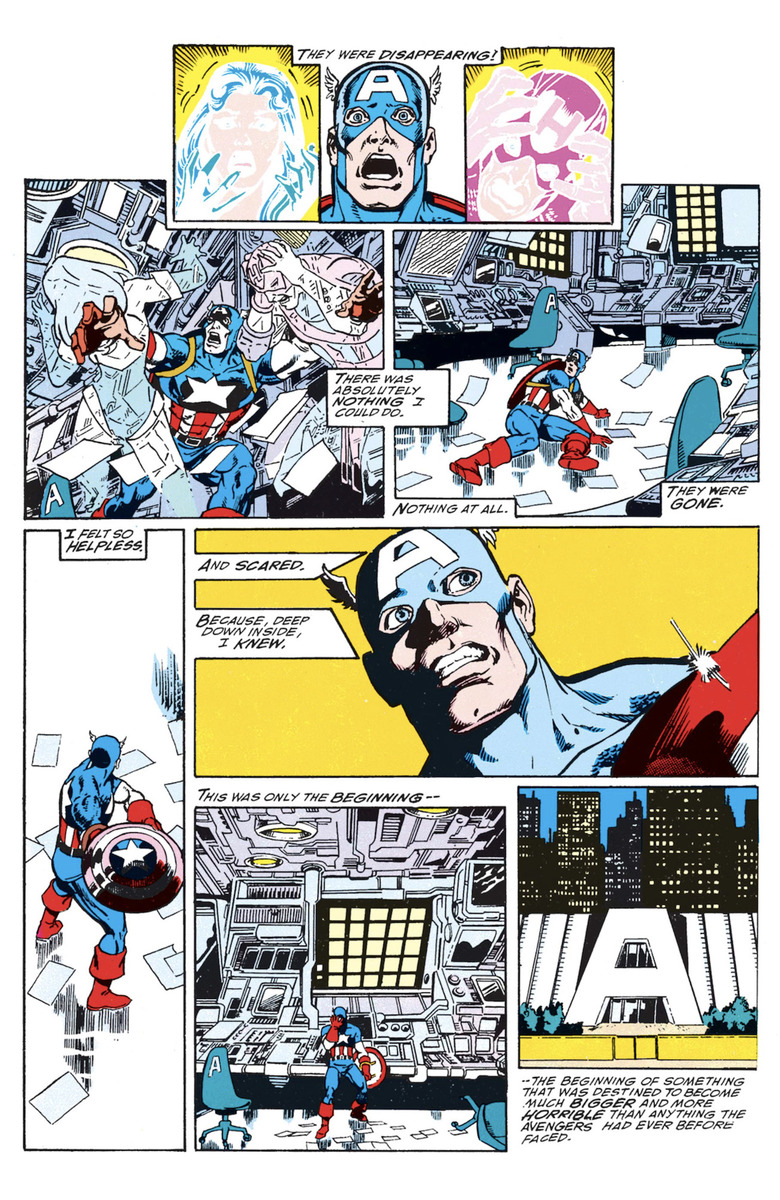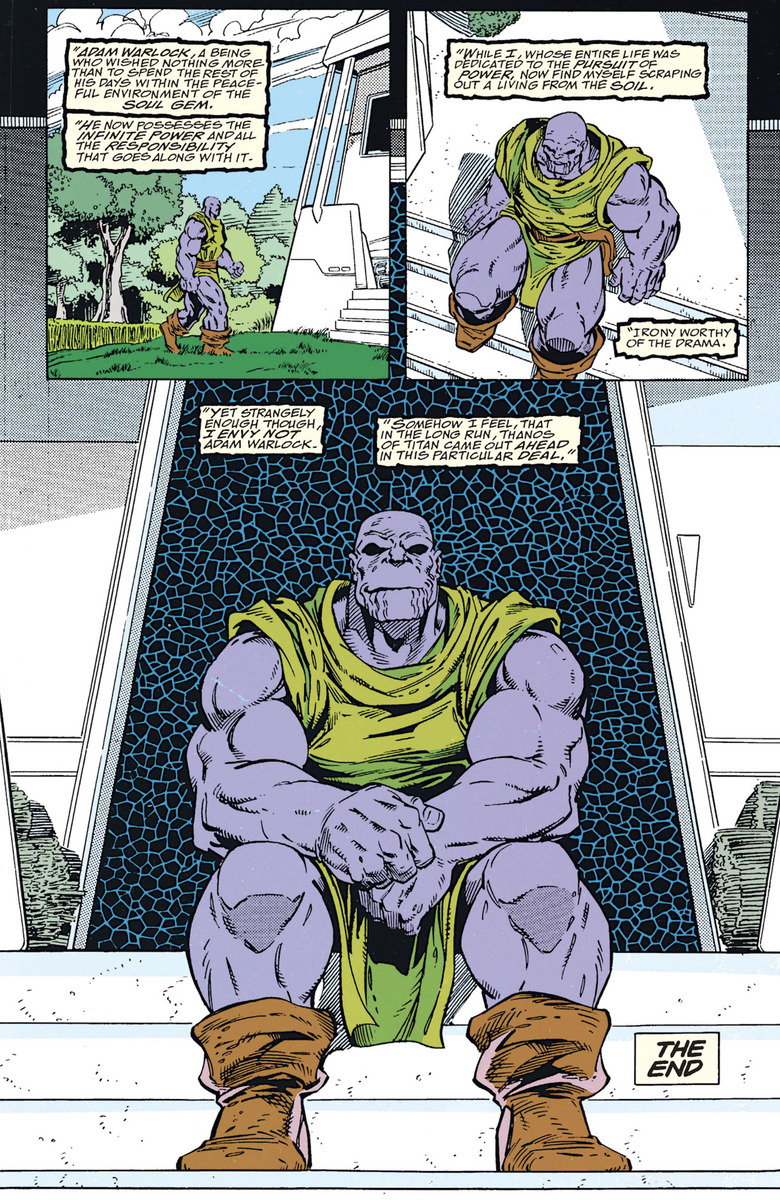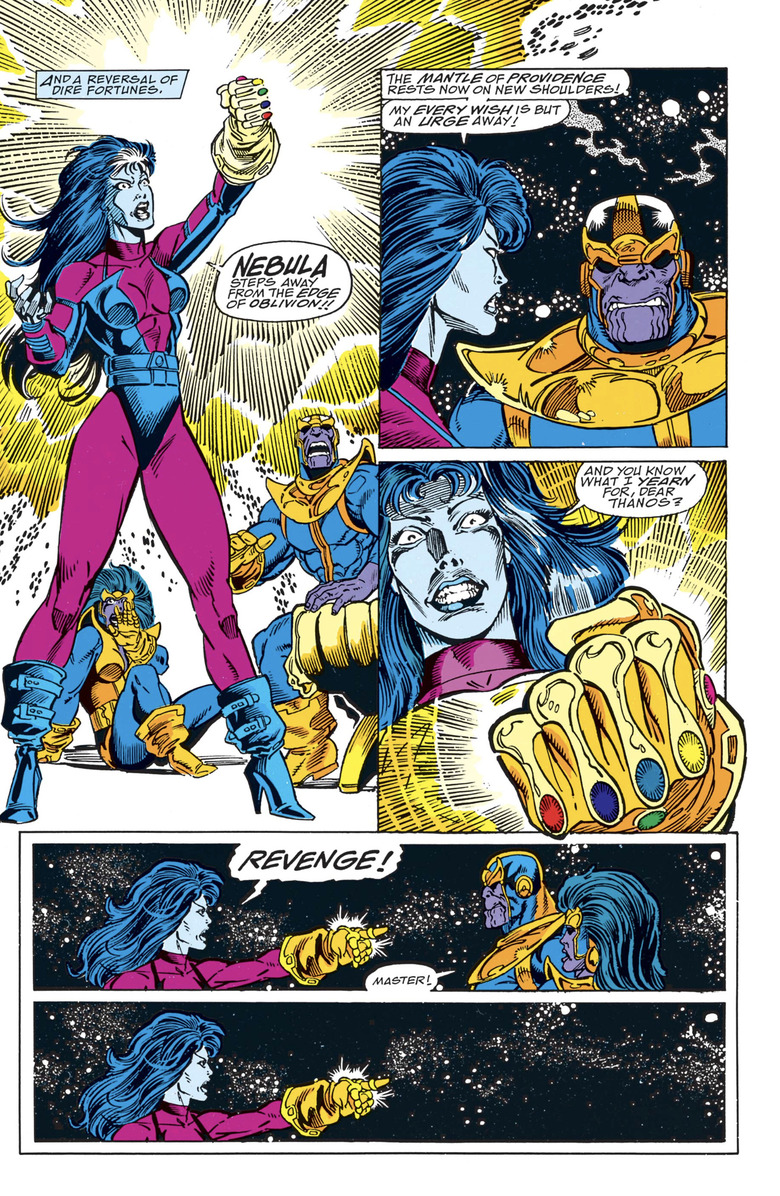12 Iconic Marvel Comics Moments That 'Avengers: Infinity War' Brings To Life
Eighteen years into the comic book movie millennium, it's easy to take for granted that there now exists a whole cinematic universe full of characters that Marvel Comics readers could previously only dream about seeing up on the big screen. What once seemed like a fan pipe dream has now become a reality with Avengers: Infinity War, a movie that brings together heroes from at least five different film series (nine if you count the MCU characters who currently only have one solo movie under their belt).
Born out of the tradition of Marvel crossovers, Infinity War leverages a decade of character-building into the ultimate mega-sequel. It's the culmination not just of Marvel's ten-year reign at the box office, but of forty years worth of comic book movies. As someone who used to sit on the floor of his bedroom and obsessively-compulsively organize his comics collection across multiple long boxes, I can still remember a time when the only remotely decent superhero films were the ones centered on Superman and Batman. If you look back to 1978 when Superman: The Movie came out and think about all that has transpired since then, the shared weight of comics and movie history speaks volumes.
The world has changed a lot since the X-Men first got their own movie and since Iron Man built the foundation of the MCU. In many ways, geekdom is no longer a sub-culture: it's the dominant culture in entertainment. And now instead of long boxes, I've got an iPad and a subscription to Marvel Unlimited, the digital comics service. So let's put those tools to good use and take a look at how Avengers: Infinity War remixes moments from the panels and pages of Marvel Comics into the blockbuster to end all blockbusters. Spoilers and comic book art abound below.
Hulk Warns "Thanos Is Coming"
Avengers: Infinity War is not the first Marvel movie where the absence of the Silver Surfer can be felt in the MCU. Last year, Thor: Ragnarok drew elements from the Planet Hulk comic book storyline, yet it substituted Hulk for Silver Surfer and inverted his role with Thor's, so that Thor was the protagonist instead of Hulk and it was actually Hulk instead of Silver Surfer who showed up as the surprise lord of the gladiator arena.
One comics-to-screen moment we knew was coming from the trailers for Avengers: Infinity War was the moment where Hulk crashes back to Earth, landing through the skylight of Doctor Strange's Sanctum Sanctorum, where he reverts to the body of Bruce Banner and warns, "Thanos is coming." In The Infinity Gauntlet #1, this same warning scene happened with Silver Surfer instead.
As it turns out, Hulk's appearance on the ground in Wakanda in the trailers was a bit of misdirection. The last we would see of the Green Goliath in this movie was him getting beaten up by Thanos on the spaceship of the Asgardians. It seems likely that the kid-like Hulk is actually scared of Thanos now and that is why he refuses to emerge, no matter how hard Banner tries to Hulk out. At least Hulk getting beaten up allowed Heimdall to go out like a champ and send Hulk rocketing back to Earth as his final act before being stabbed through the heart.
The Iron Spider
In Avengers: Infinity War, Tom Holland proves once again that he is the best Peter Parker/Spider-Man, capable of embodying the character's youthful vitality in a way that is more faithful to the comics than either of his big-screen predecessors. The suit of Spider-armor that Iron Man provides his character as they are rocketing into space on Ebony Maw's ship is based on the Iron Spider costume, which first appeared in Amazing Spider-Man #529.
That was the first of a three-issue Road to Civil War arc entitled, "Mr. Parker Goes to Washington." It was actually the next issue, in a hotel room in Washington, D.C., when Peter first activated the set of spider-legs on the back of the armor. In issue #534, part of the follow-up story arc "The War at Home" (a Civil War tie-in), Spider-Man memorably springs the legs on Captain America in the midst of a hero-on-hero fight. This is reminiscent of the scene in the movie where Spider-Man briefly tangos with Star-Lord after Ebony Maw's ship has arrived on the planet Titan.
Interestingly enough, the trip to Washington, D.C. and Spider-Man's subsequent struggle with Titanium Man in the air over the Washington Monument may have served as part of the inspiration for a similar sequence we saw in Spider-Man: Homecoming (sans Titanium Man, of course.) Furthermore, the whole mentoring dynamic that exists on-screen now between Tony Stark and Peter Parker is firmly rooted in the Civil War and pre-Civil-War era of comics. For his part, Robert Downey, Jr. turned Tony Stark into more of a wise-cracking hotshot than he ever was in the comics, setting the template for other heroes in the MCU like Peter Quill and Doctor Strange, who are always quick with a quip and fast on their feet in the face of danger.
Ebony Maw Tortures Doctor Strange
Another comics moment we already knew was coming from the trailers for Avengers: Infinity War is the moment in which Ebony Maw seeks to extract information from Doctor Strange. Of all the Children of Thanos (a.k.a. the Black Order, his four alien lieutenants, who first appeared in Infinity #1), Ebony Maw is the only one who makes much of an impression as a full-fledged character, as opposed to a CG construct. If there's any weak point in Infinity War, it's that even with the great Carrie Coon of The Leftovers and Fargo fame voicing her, the horned villainess Proxima Midnight sometimes looks about as awkward as Steppenwolf did in Justice League last year.
Ebony Maw, however, is actually somewhat chilling as the worshipful acolyte who exhorts victims like the Asgardians to "rejoice" that they have been selected for death by Thanos. Nearly invincible on his own, the character vividly embodies the kind of fanatical death-cult member who would naturally find his way into the retinue of a being like Thanos. His torture of Doctor Strange onboard his spaceship, right before Iron Man and Spider-Man blow him out into space in an Aliens homage (R.I.P. Ebony Maw, gone too soon) brings to life a page from New Avengers #9, with the added bonus of some cosmic spikes through the face of Doctor Strange.
Hooded Skull-Face
One big surprise Avengers: Infinity War holds is the reveal that Red Skull, last seen at the end of Captain America: The First Avenger, is still alive and now the gatekeeper of the Soul Stone. Fans may be so caught up in the cameo that they don't even realize at first (I certainly didn't) that the role of the Red Skull has been recast. It's actually the face of Ross Marquand, who plays Aaron on The Walking Dead, that dwells behind the makeup now. Marquand's Hugo Weaving impression is so convincing and the structure of his face looks so similar in that red makeup that it's as smooth a bit of recasting as there ever was in a movie or TV show (or a series of movies that plays like a big-screen TV show).
Again, fans might be so caught up in the cameo that they miss another aspect of the Red Skull's reappearance: namely, how his hooded skull-face functions as an homage to the character of Death. It was Thanos' love for Death that drove his demented, genocidal aspirations in The Infinity Gauntlet mini-series, but in Avengers: Infinity War, the character was excised from an already-overcrowded cast in favor of a new backstory for Thanos whereby he is driven by a desire to bring balance to the universe through population control.
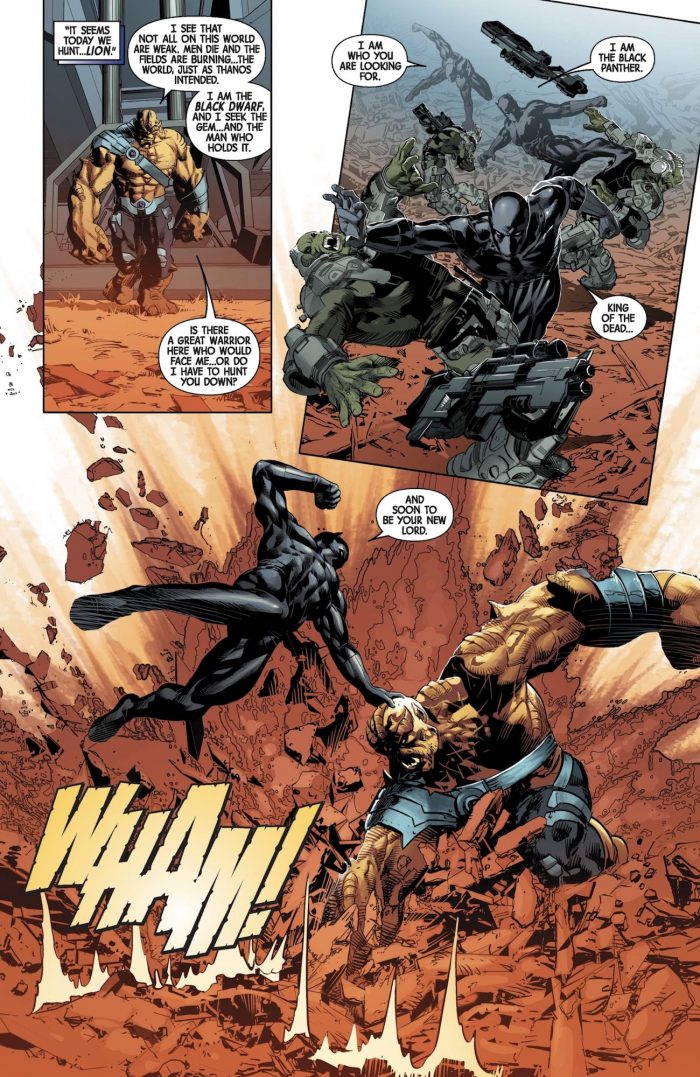
The Battle of Wakanda
Black Panther was glorious to behold and it's a testament to the movie's power that one of the biggest goosebump-inducing moments in Infinity War comes when it cuts to Wakanda for the first time and we see that huge panther statue and hear Ludwig Goransson's musical theme for Black Panther again. In New Avengers #9 and Infinity #2, we do get three pages and one panel showing part of the invasion of Wakanda by Thanos' forces. Most of the conflict happens off-page, however, as the comic cuts to other locations like The Jean Grey School, home of the X-Men, and Atlantis, the underwater kingdom of Namor the Sub-Mariner.
In the movie, Black Panther does momentarily spar with Thanos' oversized lieutenant Cull Obsidian (known as Black Dwarf on the comics page), just as he does in New Avengers #9. Yet as a whole, the Battle of Wakanda is a much more massive set piece in the movie than it ever was in the comics. Having hordes of Outriders (another detail brought to life from the Infinity mini-series) clash with the tribes of Wakanda is what mainly justifies the movie's title of Infinity War. That title was actually taken from another comics event, which involved the heroes of the Marvel universe clashing with swarms of evil doppelgangers based on themselves. Like Age of Ultron (which some have argued is the best Avengers film), this is one of those Marvel movies where the title bears little resemblance to the actual comics event where it originated.
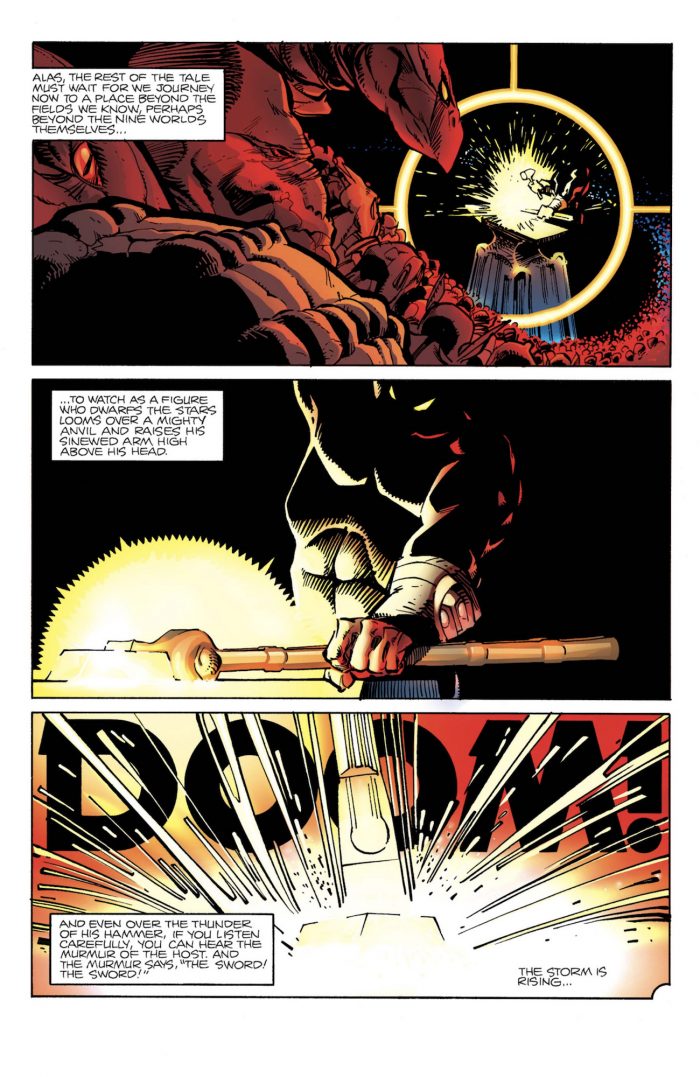
Eitiri The Dwarf Forges Stormbreaker
One of the more perplexing moments for non-comics readers in Avengers: Infinity War might come when Peter Dinklage (Games of Thrones) shows up as an oversized space-dwarf whose deep, goofy voice almost sounds at times like that of another character impersonating Thor, the way Star-Lord does earlier in the movie. Dinklage is playing Eitri, the dwarf leader who, in the comics, forged a new hammer for Beta Ray Bill after Bill defeated Thor in single combat in Thor #339.
This issue preceded the classic "Surtur Saga," another one of the inspirations for last year's Thor: Ragnarok. Toward the end of that issue, there's a glorious splash page where Bill is shown in his own Thor costume for the first time. The movie gives us something similar when Thor makes his thunderous rearrival on Earth, looking spiffy again in a clean costume. Others have pointed out that Thor's new ax-hammer, Stormbreaker, looks more "like the Mjolnir from a parallel dimension" (Earth-1610, the Ultimate Universe). The movie combines the two versions and throws in a neat added twist whereby one of Groot's snaking tree limbs serves as the hammer handle.

Web In The Face/Celestial Objects as Weapons
Mainstream moviegoers have now had their minds blown the way the minds of comics readers were blown when they first read The Infinity Gauntlet #4 back in 1991. That is the issue in which Thanos kills most of the assembled heroes, including a cosmic task force led by Captain America on the edge of space. One by one in that issue, major characters like Wolverine, Spider-Man, and Thor meet a grisly fate at the hands of the Mad Titan and Terraxia, the purple-skinned She-Thanos consort he has conjured for himself out of thin air. It's the kind of crazy comic book battle royale where you see Iron Man struggling on the ground with Terraxia in one panel, and then, all of a sudden, in the corner of the next panel, you see Iron Man's decapitated helmet-head bouncing across the ground like a basketball.
The movie does take us to Titan, the homeworld of Thanos, where we get to see him square off against an assortment of heroes led by Tony Stark (though Star-Lord would probably insist he was the leader, not Tony). There's a direct callback to the fight that took place in issue #4 when Spider-Man swings in and webs Thanos in the face. In issue #5, after killing most of Earth's heroes, Thanos also fights the cosmic beings of the Marvel universe, and there's one panel where the Celestials are shown drafting "helpless planets into the conflict, using them as weapons of war."
The movie opts to scale it down to a single moon, which Thanos breaks up into falling asteroid rocks. It looks like those rocks become a swarm of bats, which then proceed to terrorize Iron Man...a rather meta moment, if you view it as an Easter-egg reference to the DC/Marvel rivalry that has long existed in the comics and would also spring up among movie fans after the first Iron Man movie and Christopher Nolan's The Dark Knight both hit theaters during the same fateful summer of 2008.
Bonus: The trippy moment when Doctor Strange sprouts extra arms and manifests multiple mirages of himself shows him casting an old magic spell from the comics known as the Images of Ikonn, which first appeared in Doctor Strange #19 back in 1976.
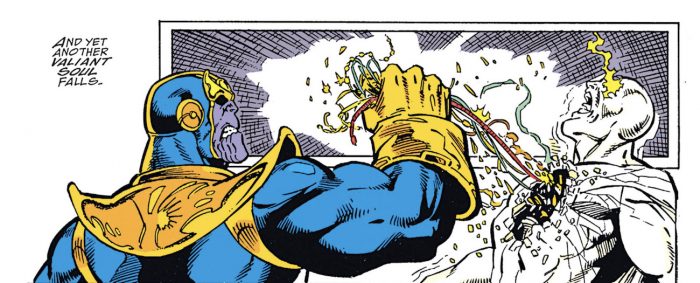
Vision's Wires/Cap's "Last Man Standing" Moment
A couple other callbacks to issue #4 happen after Thanos steps through the wormhole to Wakanda. The way Vision dies, with Thanos ripping circuits and cords out of his chest, exposing his inner wiring, is mirrored a bit in the movie with what happens to Paul Bettany's red-and-green android's forehead.
The last man standing in the comics battle is Captain America. Always the picture of great dignity, Cap strides over to where Thanos is standing and faces off with him even though he is clearly outmatched and it is suicide to do so.
In the movie, Thanos charges toward Vision, swatting aside heroes like flies, only to meet a final roadblock in the form of Steve Rogers. The way their face-off is framed, with Thanos rising tall over Rogers, exerting force downward on him, is similar to the way it was done in the comics (though Rogers lacks his signature shield in the movie encounter, having cast it aside along with the Captain America identity at the end of Captain America: Civil War).
The Snap Heard 'Round The World
Avengers: Infinity War goes to great pains to set up the moment where Thanos conducts genocide with a mere snap of his fingers. We are reminded of it at least twice before it happens so that the audience will realize how the power of the gauntlet is being used at that instant.
In The Infinity Gauntlet mini-series, this moment came near the end of the first issue and was in many ways the catalyst that set the whole plot in motion. Loki might have made a good surrogate for the Silver Surfer villain Mephisto, who serves as an obsequious advisor to Thanos throughout the mini-series right up until the moment he betrays him and attempts to grab the gauntlet for himself. Mephisto is the one who stands by watching and remarks, "He's really going to do it" in the otherwise silent series of comic panels leading up to the finger-snapping moment.
As it is, Loki's obsequiousness-turned-betrayal is accelerated early on and he is long dead in the movie by the time the snap serves as its stunning climax.
Half The Universe's Population Ceases To Exist
Though it has mostly enjoyed a positive response, a common criticism of Avengers: Infinity War, is that the movie feels open-ended, like it dishes out a big cliffhanger. Part of the reason for that is because we movie news nerds are bringing in outside knowledge of the release slate for upcoming Marvel movies. If you take the story at face value, however, it does have a pretty conclusive ending.
The heroes lose. Thanos wins. He does what he set out to do and extinguishes half of all life in the universe. Characters disintegrate, their bodies crumbling into dust, and in the movie, as in the comics, Steve Rogers is the first to witness heroes being willed out of existence by the Mad Titan.
The funny thing is, in The Infinity Gauntlet #1, Hawkeye is one of the two heroes Cap sees fade into nothingness. But even before Infinity War hit theaters, Hawkeye had already pulled a disappearing act in the marketing, leading fans to speculate that he might not be in the movie at all (which he isn't, save for a reference in the dialogue to him and Ant-Man being under house arrest).
On the comics page, the other hero Cap sees vanish is Sersi, a character who hasn't been introduced into the MCU yet (but who is an Eternal and could very well have a part to play in the studio's rumored Eternals movie should that indeed come to fruition). In the absence of Hawkeye and Sersi, therefore, the hero we first see disintegrate through Steve Rogers' perspective is Bucky Barnes, a character with whom he shares a close personal connection.
Thanos's Happy Ending
At the end of Avengers: Infinity War, Thanos sits smiling on his front porch, watching the sun rise on a new, depopulated Marvel Cinematic Universe. It's an ending that clearly echoes the last few pages of The Infinity Gauntlet #6, the final issue of the comic book mini-series. Those pages show a Thanos who seems somewhat content in his failure at godhood, having retired to a quiet farm to "digest and incorporate the lessons the past has forced upon [him]."
Writer Jim Starlin, who created the character of Thanos and is thanked in the closing credits "for his significant contribution" to Avengers: Infinity War, often treated Thanos as both a villain and as something of an anti-hero. Likewise, producer Kevin Feige has said, "you could almost go so far as to say [Thanos] is the main character" of Infinity War. Screenwriters Stephen McFeely and Christopher Markus came right out and said it: "It's Thanos' movie."
Without a doubt, the force of his resolve, the strength of his will — and just pure strength — coupled with a degree of emotional complexity establishes Thanos as something of a mighty antidote to Marvel's villain problem (though I would argue that the Winter Soldier made for a terrifying villain, one who could literally stop traffic, and there have been other visually effective villains in the MCU like Red Skull and Loki). In lieu of the traditional hero's name, we even get that fun little capper in the credits telling us, "Thanos Will Return."
If the world ends tomorrow and we never see another Marvel movie, there will have been a fairly definitive end to this 10-year story Marvel Studios has been telling. It's an ending that beggars belief in a lot of ways ("Wait, that can't happen! The villain can't sit triumphant! The heroes can't die!"), but it's an ending nonetheless.
Warning: Potential SPOILERS for Avengers 4 on the next page. Continue reading at your own risk!
Nebula Undoes Everything
I'm including this as a bonus section because the fact of the matter is there's another Avengers movie scheduled for May 3, 2019, and the story will continue. Even if you don't count the Captain Marvel tease in Infinity War's post-credits scene, there are still a few plot threads left dangling at the end of the movie. One of those is the subplot with Hulk hiding inside Banner; another is the question of what happened to characters like Black Panther's sister, Shuri, who dropped out of sight before the disappearance of half the universe. Moreover, there's the implication that Doctor Strange's sacrifice of the Time Stone means it was necessary for Iron Man to stay alive and reunite with the core group of original Avengers in order for this to be the one reality in which the heroes prevail against Thanos.
In Infinity War, after Doctor Strange, Spider-Man, and the Guardians of the Galaxy disintegrate, the only character left alive with Tony Stark on Titan is Nebula, the second adopted daughter of Thanos. In The Infinity Gauntlet mini-series, Nebula is forced to live in a state of "walking death" as her corpse-like form serves as a plaything for Thanos. The torture she undergoes at his hands is echoed a couple different ways in the movie.
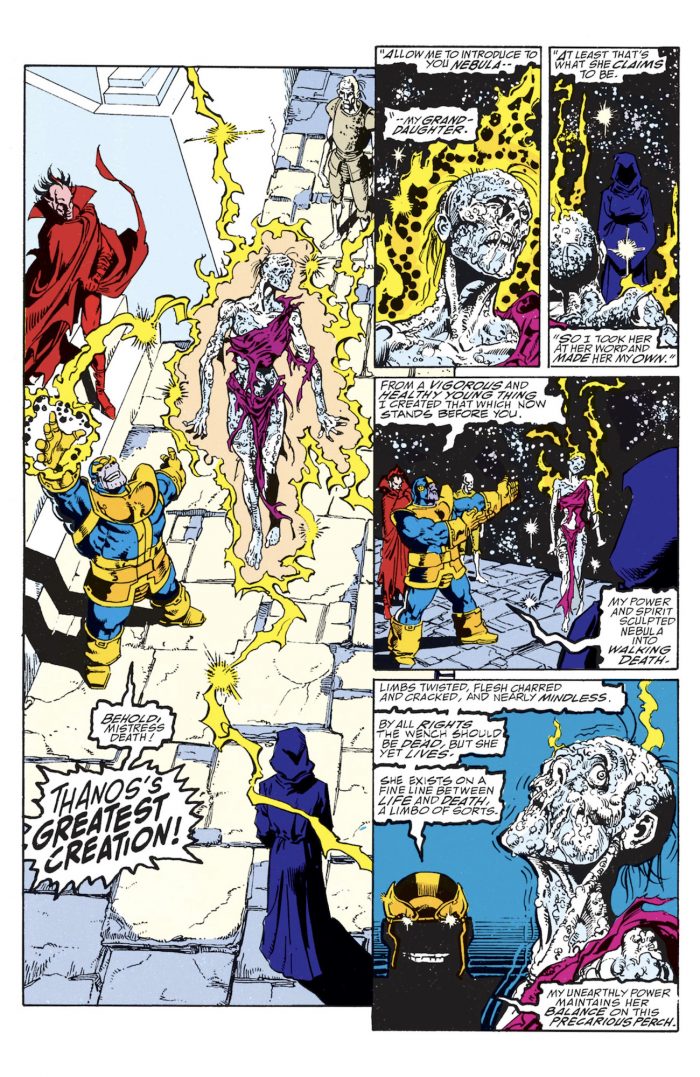
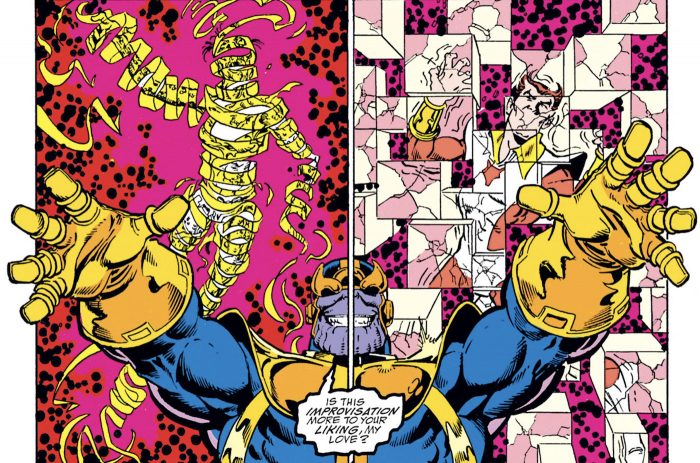
First, there's the actual torture scene where Thanos pulls her cybernetic body apart as a means of mining answers from Gamora about the location of the Soul Stone. The anguished screams of actress Karen Gillan lend this scene a real horror-movie vibe. Some of the torture she undergoes in the comics is transposed onto other characters in the movie, however. The scene where Thanos causes the bodies of Drax and Mantis to break up into blocks and ribbons has a direct corollary in one panel of The Infinity Gauntlet #2 where Thanos is shown doing the same thing to Eros and Nebula. (In the comics, Eros, a.k.a. Starfox, is the brother of Thanos and Nebula is his granddaughter. It's a family feud.)
The point is, Nebula has a very bitter, personal grudge against Thanos, and when she gets ahold of the gauntlet, she decrees, "With the exception that I retain possession of the Infinity Gauntlet, let everything be as it was twenty-four hours ago!" Among other things, this brings back to life all the heroes who have died. Resurrections and retcons: that's comics for you.
Fans need not be too worried about some of the Phase 2 and Phase 3 heroes who disintegrated at the end of Infinity War (especially not those with already-announced sequels like Spider-Man and the Guardians of the Galaxy). It's probably best to take the movie's ending in the spirit of Black Panther's rallying cry: "Wakanda forever!" Since it's a story that does involve time travel, maybe the title of the next movie will be Avengers: Forever.

